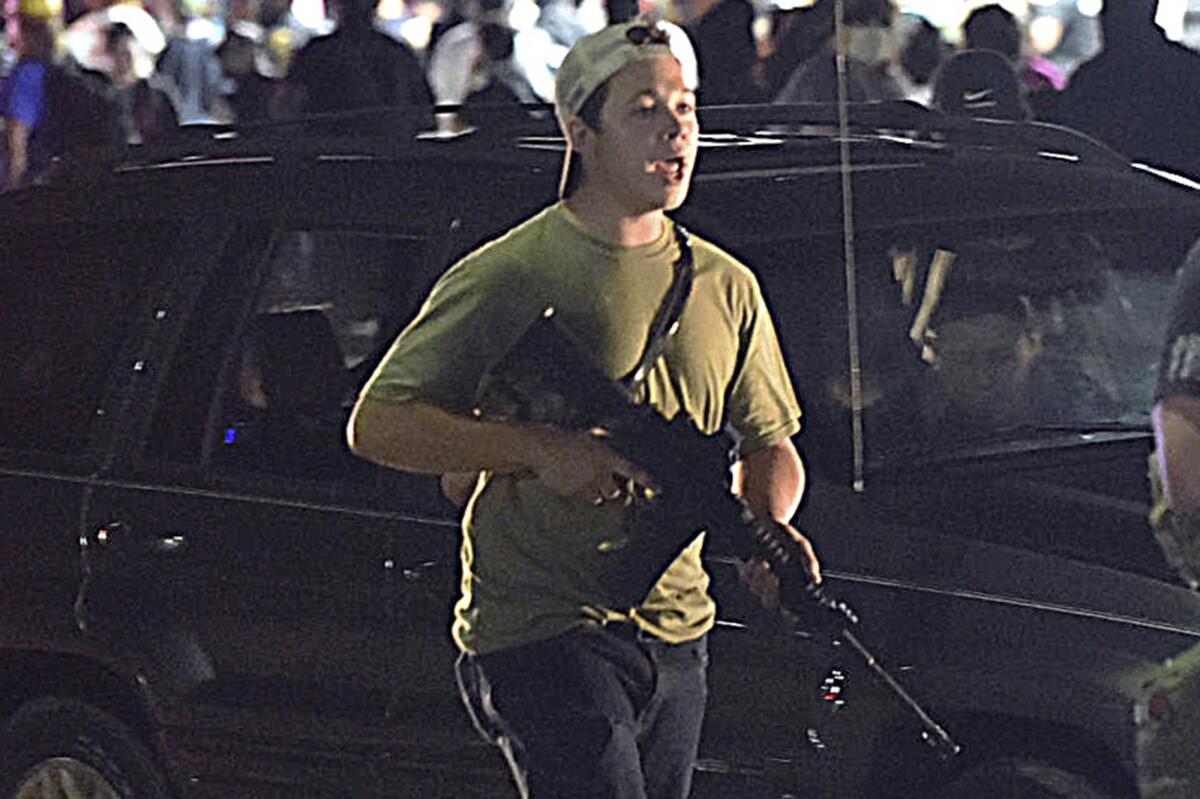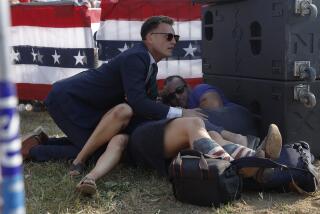In gun debate, Rittenhouse verdict unlikely to be last word

- Share via
Kyle Rittenhouse walked the streets of Kenosha, Wis., a rifle slung around his chest and shoulder.
The weapon was supposed to be for hunting on a friend’s property up north, the friend says. But on that night in August 2020, Rittenhouse says, he took the Smith & Wesson AR-style semiautomatic with him as he volunteered to protect property damaged during protests the previous evening. Before midnight, he used it to shoot three people, killing two.
After a roughly two-week trial, a jury will soon deliberate whether Rittenhouse is guilty of charges, including murder, that could send him to prison for life. Was the then-17-year-old forced to act in self-defense while trying to deter crime, as he and his defense attorneys say? Or did Rittenhouse — the only person in a well-armed crowd to shoot anyone — provoke people with his weapon, instigating the bloodshed, as prosecutors argue?
It’s a similar debate to what has played out across the country around the use of guns, particularly at protests like the one in Kenosha over the shooting of Jacob Blake, a Black man, by a white police officer or in other cities over pandemic-related restrictions. In Rittenhouse, some see a patriot defending an American city from destruction when police were unwilling or too overwhelmed to do so. Others see an irresponsible kid in over his head, enamored with brandishing a firearm, or someone looking for trouble or people to shoot.
On the streets of Kenosha that night, Rittenhouse was notable to some for his apparent youthfulness. But, for a while anyway, he was just another person with a gun.
___
The Kenosha protest was one of many that year to draw armed militias or counterprotesters. Protesters, too, were armed, Kenosha Police Officer Pep Moretta and others testified.
“We were surrounded all night,” Moretta said, adding “there was probably more people armed with weapons than not.”
The shooting occurred as the COVID-19 pandemic raged in the U.S. and three months after the killing of George Floyd, a Black man, by a white police officer in Minneapolis prompted protests — some violent — in cities big and small. The campaign between then-President Trump and former Vice President Joe Biden was heating up, with an increase in homicides and calls to “defund the police” a major focus.
All of those factors, experts say, led to a historic spike in the number of background checks to buy or possess a firearm, a key barometer of gun sales. In 2020, the FBI’s National Instant Criminal Background Check System database reported almost 39.7 million background checks for gun purchases — more than double the 14.4 million in 2010.
Rittenhouse wasn’t old enough to buy a firearm. But in May 2020 he gave money to his sister’s boyfriend, Dominick Black, with whom he had gone shooting in northern Wisconsin, and Black bought the Smith & Wesson for him. The gun was supposed to remain in a safe at the home of Black’s stepfather, Black testified.
Then on Aug. 23, a white Kenosha police officer responding to a domestic disturbance call shot Blake, who investigators said was armed with a knife. The shooting sparked the protests in which people damaged buildings and started fires, at one point burning more than 100 vehicles in the lot of a car dealership.
Black said that was when his stepfather got the guns out of his safe in the garage and brought them into the house.
On Aug. 25, Rittenhouse traveled to Kenosha from his home in Illinois. He and Black helped clean up businesses damaged in the unrest, then went back to Black’s house. When they left again for the scene of the protests, they both took their guns.
___
Richie McGinniss, the chief video director for the Daily Caller, a conservative news site, arrived in Kenosha after working at other protests around the country. This protest was different because Wisconsin law allows some people to openly carry weapons, and he testified that as he followed Rittenhouse through the night, he sensed something bad could happen.
Ryan Balch said he carried an AR-style rifle that night and wore body armor to protect himself from protesters who were armed. The former Army infantryman said he patrolled streets with Rittenhouse, who told Balch he was 19 and an EMT, and thought he seemed like “a young and impressionable kid” and ”a little underequipped and underexperienced.”
Gaige Grosskreutz, a protester and volunteer medic, carried a loaded pistol. A supporter of the 2nd Amendment right to bear arms, he said it was the same as any other day: “It’s keys, phone, wallet, gun.”
Grosskreutz became the third person shot by Rittenhouse that night. He testified that he drew his weapon because he believed Rittenhouse, who had already fatally shot Joseph Rosenbaum and Anthony Huber, was an active shooter. He said Rittenhouse shot him in the arm right after Grosskreutz unintentionally pointed his pistol toward the 17-year-old.
___
Rittenhouse, who faces a misdemeanor charge of possession of a dangerous weapon by a person under 18 in addition to homicide charges, testified he did nothing wrong and was defending himself when he fired his rifle. Prosecutors say the former police youth cadet who liked to play video shooting games was taking those fantasies to the streets.
For a lot of people, Rittenhouse is the face of gun owners in America, said David Yamane, a sociology professor at Wake Forest University who studies gun culture.
But that is a misconception, he said. In Kenosha, the more typical gun owner was the father who took weapons out of a safe amid unrest, or Grosskreutz, who carried a concealed pistol as a matter of course.
And although Rittenhouse’s core supporters believe he did nothing wrong from start to finish, a much larger group of gun owners “are somewhere in between,” Yamane said. Although they support Rittenhouse’s right to defend himself in the moment, they also think he had no business being there, and that “two people died and one person was injured for no good reason.”
Former gun industry executive Ryan Busse, now senior policy advisor to the gun-safety group Giffords, calls Rittenhouse the “avatar” of a customer the NRA and gun companies have been appealing to, including by marketing and selling products with names like the Ultimate Arms Warmonger.
Among much of society, whether Rittenhouse is guilty or not guilty won’t change anyone’s minds about guns, he said.
“What’s dangerous is he’s going to become a mascot or a martyr,” Busse added. “Every time there’s a Rittenhouse, it moves the window of what’s acceptable. I think Rittenhouse has moved the window.”
___
Find AP’s full coverage on the trial of Kyle Rittenhouse at: https://apnews.com/hub/kyle-rittenhouse
More to Read
Sign up for Essential California
The most important California stories and recommendations in your inbox every morning.
You may occasionally receive promotional content from the Los Angeles Times.










